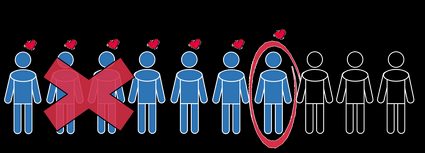Dating Theory Calculator
In the era of Tinder swipes and Bumble matches, meeting new people online is as easy as ordering takeout, 🥡 but finding the perfect partner is still as tricky as assembling IKEA furniture without the instructions. 👷 How can you be sure that your dinner date isn't just a catfish in disguise? Sure, you could try opening a nether portal and summoning love from another dimension, but let's face it — that's an impossible feat — as we verified it with the Drake equation for love calculator.
Instead, boost your odds of landing your perfect partner by using... math.
Romantic, we know.
Mathematicians developed a theory called the , the primary purpose of which is to find the most effective strategy for maximizing an expected payoff.
In our dating theory calculator, we use it to finally solve (or at least help to solve) the eternal problem of finding the right lifetime partner. What's more, we further improved it to make it more realistic and practical. Take some time to explore it in detail, and find out why love is often called a numbers game!

What is the optimal stopping problem?
The optimal stopping problem has many different names: the secretary problem, the sultan's dowry problem, the 37 percent rule, or the googol game... The essence of all of them is the same: find the best option from sequentially observed random variables. Sounds complicated? It's not that bad if we explain it with an example!
To stick to this calculator's topic, we'll think about choosing the ideal partner. Let's say that, during your lifetime, you will meet ten people that you could really love and live with. Which one should you pick? Obviously, the best one! The problem is that you cannot gather them all in a room, use a grade calculator or a test grade calculator, and assign a score for each one, so you can find which one is right for you.
Instead, you will date them one by one, in a random order, with less suitable partners thrown in. You don't know whether the person you're currently dating is your soulmate. Maybe the next one will be a much more suitable choice for you? Besides, more often than not, you cannot go back to rejected partners. So, herein lies the problem. Choose too early, and you might not even meet the perfect one — wait too long, and you will have already rejected Mr. or Mrs. Right.

So, how do you find the love of your life? Well, this is where math and probability become truly helpful, even if, on the surface, it seems like it's all about luck. It turns out that the best strategy is, out of the total number of potential dates you will go on, to reject the first 37% of them (precisely 1/e ≈ 36.79%, where e is the Euler's number (e ≈ 2.71828).
Of our ten people above, we will need to reject the first four. It doesn't matter how good they seem; reject them. The next step is to pick the next person who is better than anyone you've ever met before. Following these instructions will give you the highest chance of meeting the very best suitor possible. In our example, the probability of choosing the best person increases to about 40%, from only 10% if you were to select randomly. Check it by yourself with our calculator!

Dating theory calculator
The optimal stopping theory doesn't just give you one number, after which you will find the right person for you. It also offers many more valuable pieces of information that you can use to find the perfect partner. This is why we created the dating theory calculator, which handles all the exhaustive estimations.
It is based mainly on the standard optimal stopping theory, but we also included some to make the calculator handier for real-life cases. How does it work? It's straightforward! All you need to do is to follow these steps:
-
Estimate how many dates you might have, or aim to have, during a time period.
-
Select which extensions of the optimal stopping theory you would like to include. You can:
-
Accept but also one of the top 5 or 10 candidates.
-
Allow potential partners to efforts.
-
-
Check the results!
-
Read what your current probability is of finding the right partner and what the risk is of remaining alone.
-
Look at the first graph — the x-axis is the number of rejected candidates. The blue points show the probability of finding a candidate that fulfills your requirements, and the yellow points are the chances that you will find any partner. The optimal stopping policy may not be suitable if the latter chances are too low. Maximizing probabilities is a vital point.
-
Even if you aim for the best partner, you may end up with a slightly worse option. Turn on the advanced mode, and enter how many partners you are ready to reject first. This will show you a new graph showing the probability of you being with each of your top 10.
-
That's it! Try different combinations to find the strategy that suits you most.
Remember that math can't take into account every possible factor, for example, human emotions. As the mathematician, Bobby Seagull, said .
People stop searching too soon
The optimal stopping problem isn't just pure mathematics. Experimental psychologists J. Neil Bearden and Amnon Rapoport have studied the decision behavior of actual people in their . Each tested person (subject) had to hire one (virtual) applicant for a position with 40 or 80 other candidates. The subjects could choose the current applicant or proceed to the next one, just as in the optimal stopping problem. Once the best overall candidate was selected, a subject was awarded either $0.30 or $0.50. Psychologists repeated this experiment 100 times on each tested person, so the total possible payoff was relatively high. What do you think? Did subjects follow the optimal policy?
Well, Bearden and Rapoport analyzed the results and demonstrated that people tend to stop earlier than is predicted by optimal stopping strategy. The propensity to stop too soon suggests that we don't search enough when we are faced with problems where we encounter options sequentially.
There are many problems of this kind in the real world. For example, drivers must decide which gas station to stop at for gas along a highway. According to the above research, they might pay more than if they had searched for longer. Another example is selling a house. You don't know the value of the offers before they come. With each offer, you must decide whether you accept or reject it. How long should you wait for the best deal?
Love is numbers game — the risks of optimal strategy
Sadly, the optimal stopping strategy doesn't have a 100 percent success rate. As explained by the mathematician Hannah Fry, the author of , during a , there are some unfortunate scenarios that you may end up in.
Imagine the perfect partner is one of the first persons you date. If you follow the optimal stopping policy, you'll reject that person. Then, you'll continue to meet other people, but no one will be as good as your ideal candidate. So, unfortunately, you'll have to go on, reject everyone else, and end up being forever alone (or surrounded by cats😺).

Another scenario is that you start your dating life with some really terrible partners. If that's so, your expectations will be super low, and you'll marry the very first person who is marginally less boring than all of the previous losers you've met. And what about all these fantastic candidates waiting just around the corner? Such a loss...

Finding the right partner is a little bit like Russian roulette, and even with the use of the optimal stopping theory, sometimes things can go wrong. Yet, keep in mind that this strategy is better than any other one you could follow. Ana Swanson from explains, simply having you choose the best out of three potential partners. She showed that the probability of finding the right one is 20% higher when using the optimal stopping strategy and increases even more when considering more candidates!
for a reason. Whenever you meet someone new and go on a date, you're automatically adding to your knowledge of what you want most in a person. You should start dating to find out what your actual expectations are, and this will increase your chances of choosing the ideal person for you. Happy hunting!
FAQ
What is the optimal stop theory of dating?
The theory suggests you should date a number of people to evaluate potential partners, then choose the next person who is better than all previous ones to maximize your chances of a good match.
What is the 37% rule in dating?
The 37% rule advises that you should spend the first 37% of your dating period evaluating potential partners and then commit to the next person who surpasses all previous ones.
What's the optimal percentage of first dates to reject to assess the dating pool?
The optimal percentage of first dates to reject is the first 37%, according to the optimal stopping theory.
This may seem like a lot of people to reject, but it's important to remember that first dates are a screening process. You're trying to figure out who is a good match for you and who isn't. If you're not feeling it with someone after one date, that's okay! Move on to the next person.
How do I calculate how many people to reject before assessing my true partner?
You can calculate the number of people to reject in three steps:
- Add up the number of dates.
- According to optimal stopping theory, you need to reject the first 37%.
- Multiply the number of dates by 37% (0.37).
For example, if the number of dates is 10, then 10 × 0.37 is 3.7. Rounding up, you should reject the first 4 people.
Math, the language of the universe, has got your back. Use this calculator to optimize your chances of success.
- Go on 33 dates and then let them all go no matter what - no callbacks in this romance script. This is your data-gathering phase.🗒️
- Keep the dates rolling until someone comes along who sparks your interest like no other, which is the moment to cast your final rose 🌹
Statistically, there's a 21.1% chance your dreamboat is docked among those first 33 dates you have to reject which could mean you'll end up alone 🥲